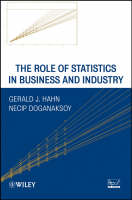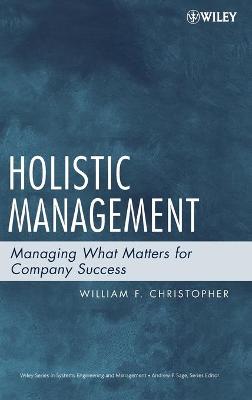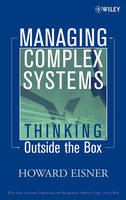Role of Statistics in Business and Industry
 -15%
portes grátis
-15%
portes grátis
Role of Statistics in Business and Industry
Hahn, Gerald J.; Doganaksoy, Necip
John Wiley & Sons Inc
08/2008
368
Mole
Inglês
9780471218746
15 a 20 dias
524
Descrição não disponível.
Major Applications. Preface.
Acknowledgments.
PART I. SETTING THE STAGE.
Chapter 1. Statistics: An Overview.
1.1 About this Chapter.
1.2 What is Statistics?
1.3 Areas of Application.
1.4 Statistical Literacy.
1.5 Better Decisions Require Better Data.
1.6 Statistical Thinking.
1.7 Related Disciplines.
1.8 Major Takeaways.
Discussion Questions.
Chapter 2. Statistics in Business and Industry.
2.1 About this Chapter.
2.2 Evolution of Statistics for Manufactured Product Applications.
2.3 Applications Beyond Manufactured Products.
2.4 Forces Impacting the Use of Statistics Today.
2.5 Major Takeaways.
Discussion Questions.
PART II. MANUFACTURED PRODUCT APPLICATIONS.
Chapter 3. Product Design: Concepts.
3.1 About this Chapter.
3.2 The Product Design Process.
3.3 Setting the Design Goals.
3.4 Ensuring Measurement Capability.
3.5 Design and Development.
3.6 Design Validation.
3.7 Transition to Manufacturing.
3.8 Major Takeaways.
Discussion Questions.
Chapter 4. Product Design: Example.
4.1 About this Chapter.
4.2 Thermoplastic Resin for Child Car Seat: Introduction.
4.3 Some Basic Elements of Plastic Part Design and Manufacture.
4.4 Setting the Design Goals.
4.5 Ensuring Measurement Capability.
4.6 Design and Development.
4.7 Design Validation.
4.8 Transition to Manufacturing.
4.9 Major Takeaways.
Discussion Questions.
Chapter 5. Product Reliability Assurance.
5.1 About this Chapter .
5.2 The Key Role of Reliability.
5.3 Design for Reliability: The Need.
5.4 The Process and the Participants.
5.5 Setting Reliability Goals.
5.6 Reliability Evaluation of a Conceptual Design.
5.7 Product Reliability Development.
5.8 Reliability Validation.
5.9 Product Safety.
5.10 Reliability Growth Analysis.
5.11 Product Burn-In.
5.12 Software Reliability.
5.13 Further Reading.
5.14 Major Takeaways.
Appendix: Product Life Distributions and Concepts.
Discussion Questions.
Chapter 6. Manufacturing Quality Improvement: Concepts.
6.1 About this Chapter.
6.2 The Need for Manufacturing Quality Improvement.
6.3 Different Industries.
6.4 Considerations in Manufacturing Quality Improvement.
6.5 Disciplined Approaches to Manufacturing Quality Improvement.
6.6 Quality Assessment and Improvement.
6.7 Statistical Monitoring.
6.8 Major Takeaways.
Discussion Questions.
Chapter 7. Manufacturing Quality Improvement: Example.
7.1 About this Chapter.
7.2 Generator Stator Bar Example.
7.3 Manufacturing Capability and Stability Assessment.
7.4 Addressing Measurement Error.
7.5 Reducing Deviations from Target and Variability.
7.6 Statistical Monitoring.
Discussion Questions.
Chapter 8. Product Manufacturing: Further Applications.
8.1 About this Chapter.
8.2 Integrating Engineering Process Control and Statistical Process Control.
8.3 Polymer Resin Example.
8.4 Materials and Parts Quality Assurance.
8.5 Final Product Assessment.
8.6 Productivity Improvement.
8.7 Major Takeaways.
Discussion Questions.
Chapter 9. Product Field Support.
9.1 About this Chapter.
9.2 Reliability Data Tracking.
9.3 Reliability Data Tracking for Nonrepairable Products.
9.4 Reliability Data Tracking for Repairable Products.
9.5 Planning the Failure Reporting System.
9.6 A Note on Product Safety .
9.7 Tracking Customer Satisfaction.
9.8 Competitive Evaluations and Advertising Claims.
9.9 Proactive Product Servicing.
9.10 Major Takeaways.
Discussion Questions.
PART III. OTHER APPLICATIONS.
Chapter 10. Pharmaceutical Products.
10.1 About this Chapter.
10.2 Drug Development: Process Overview.
10.3 The Role of a Pharmaceutical Statistician: An Overview.
10.4 Preclinical Studies.
10.5 Clinical Studies.
10.6 Case Study: Phase 2 Clinical Trial.
10.7 Regulatory Review.
10.8 Some Other Applications.
10.9 Some Statistical Tools Used in Pharmaceutical Applications.
10.10 Sources of Further Information.
10.11 Major Takeaways.
Discussion Questions.
Chapter 11. Financial Services.
11.1 About this Chapter .
11.2 Financial Services and Its Uncertainties: .
11.3 Credit Scoring for Consumer Loan Approval .
11.4 Credit Scoring Example .
11.5 Model Development and Implementation: Some Important Nitty-Gritties.
11.6 Modeling in Credit Management: A Broader Look.
11.7 Specific Application Areas.
11.8 Statisticians in Financial Services.
11.9 Further Reading.
11.10 Major Takeaways.
Discussion Questions.
Chapter 12. Business Processes.
12.1 About this Chapter.
12.2 Business Processes.
12.3 Example: Improving the Loan Decision Process for a Business Equipment Financing Company.
12.4 Steps for Process Improvement.
12.5 Another Example: Improving the Skip Tracing Process.
12.6 Some Further Concepts and Methods.
12.7 Operations Research and Management Science.
12.8 Major Takeaways.
Discussion Questions.
Chapter 13. Further Applications.
13.1 About this Chapter.
13.2 Food, Beverage and Related Industries.
13.3 Semiconductor Industry.
13.4 Communications Industry.
13.5 Statistical Image Analysis for Medical, Security and Other Applications.
13.6 Other Application Areas.
13.7 Emerging Areas: A Glance Into the Future.
13.8 Major Takeaway.
Discussion Questions.
References.
Index.
Acknowledgments.
PART I. SETTING THE STAGE.
Chapter 1. Statistics: An Overview.
1.1 About this Chapter.
1.2 What is Statistics?
1.3 Areas of Application.
1.4 Statistical Literacy.
1.5 Better Decisions Require Better Data.
1.6 Statistical Thinking.
1.7 Related Disciplines.
1.8 Major Takeaways.
Discussion Questions.
Chapter 2. Statistics in Business and Industry.
2.1 About this Chapter.
2.2 Evolution of Statistics for Manufactured Product Applications.
2.3 Applications Beyond Manufactured Products.
2.4 Forces Impacting the Use of Statistics Today.
2.5 Major Takeaways.
Discussion Questions.
PART II. MANUFACTURED PRODUCT APPLICATIONS.
Chapter 3. Product Design: Concepts.
3.1 About this Chapter.
3.2 The Product Design Process.
3.3 Setting the Design Goals.
3.4 Ensuring Measurement Capability.
3.5 Design and Development.
3.6 Design Validation.
3.7 Transition to Manufacturing.
3.8 Major Takeaways.
Discussion Questions.
Chapter 4. Product Design: Example.
4.1 About this Chapter.
4.2 Thermoplastic Resin for Child Car Seat: Introduction.
4.3 Some Basic Elements of Plastic Part Design and Manufacture.
4.4 Setting the Design Goals.
4.5 Ensuring Measurement Capability.
4.6 Design and Development.
4.7 Design Validation.
4.8 Transition to Manufacturing.
4.9 Major Takeaways.
Discussion Questions.
Chapter 5. Product Reliability Assurance.
5.1 About this Chapter .
5.2 The Key Role of Reliability.
5.3 Design for Reliability: The Need.
5.4 The Process and the Participants.
5.5 Setting Reliability Goals.
5.6 Reliability Evaluation of a Conceptual Design.
5.7 Product Reliability Development.
5.8 Reliability Validation.
5.9 Product Safety.
5.10 Reliability Growth Analysis.
5.11 Product Burn-In.
5.12 Software Reliability.
5.13 Further Reading.
5.14 Major Takeaways.
Appendix: Product Life Distributions and Concepts.
Discussion Questions.
Chapter 6. Manufacturing Quality Improvement: Concepts.
6.1 About this Chapter.
6.2 The Need for Manufacturing Quality Improvement.
6.3 Different Industries.
6.4 Considerations in Manufacturing Quality Improvement.
6.5 Disciplined Approaches to Manufacturing Quality Improvement.
6.6 Quality Assessment and Improvement.
6.7 Statistical Monitoring.
6.8 Major Takeaways.
Discussion Questions.
Chapter 7. Manufacturing Quality Improvement: Example.
7.1 About this Chapter.
7.2 Generator Stator Bar Example.
7.3 Manufacturing Capability and Stability Assessment.
7.4 Addressing Measurement Error.
7.5 Reducing Deviations from Target and Variability.
7.6 Statistical Monitoring.
Discussion Questions.
Chapter 8. Product Manufacturing: Further Applications.
8.1 About this Chapter.
8.2 Integrating Engineering Process Control and Statistical Process Control.
8.3 Polymer Resin Example.
8.4 Materials and Parts Quality Assurance.
8.5 Final Product Assessment.
8.6 Productivity Improvement.
8.7 Major Takeaways.
Discussion Questions.
Chapter 9. Product Field Support.
9.1 About this Chapter.
9.2 Reliability Data Tracking.
9.3 Reliability Data Tracking for Nonrepairable Products.
9.4 Reliability Data Tracking for Repairable Products.
9.5 Planning the Failure Reporting System.
9.6 A Note on Product Safety .
9.7 Tracking Customer Satisfaction.
9.8 Competitive Evaluations and Advertising Claims.
9.9 Proactive Product Servicing.
9.10 Major Takeaways.
Discussion Questions.
PART III. OTHER APPLICATIONS.
Chapter 10. Pharmaceutical Products.
10.1 About this Chapter.
10.2 Drug Development: Process Overview.
10.3 The Role of a Pharmaceutical Statistician: An Overview.
10.4 Preclinical Studies.
10.5 Clinical Studies.
10.6 Case Study: Phase 2 Clinical Trial.
10.7 Regulatory Review.
10.8 Some Other Applications.
10.9 Some Statistical Tools Used in Pharmaceutical Applications.
10.10 Sources of Further Information.
10.11 Major Takeaways.
Discussion Questions.
Chapter 11. Financial Services.
11.1 About this Chapter .
11.2 Financial Services and Its Uncertainties: .
11.3 Credit Scoring for Consumer Loan Approval .
11.4 Credit Scoring Example .
11.5 Model Development and Implementation: Some Important Nitty-Gritties.
11.6 Modeling in Credit Management: A Broader Look.
11.7 Specific Application Areas.
11.8 Statisticians in Financial Services.
11.9 Further Reading.
11.10 Major Takeaways.
Discussion Questions.
Chapter 12. Business Processes.
12.1 About this Chapter.
12.2 Business Processes.
12.3 Example: Improving the Loan Decision Process for a Business Equipment Financing Company.
12.4 Steps for Process Improvement.
12.5 Another Example: Improving the Skip Tracing Process.
12.6 Some Further Concepts and Methods.
12.7 Operations Research and Management Science.
12.8 Major Takeaways.
Discussion Questions.
Chapter 13. Further Applications.
13.1 About this Chapter.
13.2 Food, Beverage and Related Industries.
13.3 Semiconductor Industry.
13.4 Communications Industry.
13.5 Statistical Image Analysis for Medical, Security and Other Applications.
13.6 Other Application Areas.
13.7 Emerging Areas: A Glance Into the Future.
13.8 Major Takeaway.
Discussion Questions.
References.
Index.
Este título pertence ao(s) assunto(s) indicados(s). Para ver outros títulos clique no assunto desejado.
industrial statistician, business statistics, industrial statistics, statistics career, professional statistician, statistics success, Reliability\cf2 improvement, Quality improvement, Role of statistics, Advanced Placement Statistics Course
Major Applications. Preface.
Acknowledgments.
PART I. SETTING THE STAGE.
Chapter 1. Statistics: An Overview.
1.1 About this Chapter.
1.2 What is Statistics?
1.3 Areas of Application.
1.4 Statistical Literacy.
1.5 Better Decisions Require Better Data.
1.6 Statistical Thinking.
1.7 Related Disciplines.
1.8 Major Takeaways.
Discussion Questions.
Chapter 2. Statistics in Business and Industry.
2.1 About this Chapter.
2.2 Evolution of Statistics for Manufactured Product Applications.
2.3 Applications Beyond Manufactured Products.
2.4 Forces Impacting the Use of Statistics Today.
2.5 Major Takeaways.
Discussion Questions.
PART II. MANUFACTURED PRODUCT APPLICATIONS.
Chapter 3. Product Design: Concepts.
3.1 About this Chapter.
3.2 The Product Design Process.
3.3 Setting the Design Goals.
3.4 Ensuring Measurement Capability.
3.5 Design and Development.
3.6 Design Validation.
3.7 Transition to Manufacturing.
3.8 Major Takeaways.
Discussion Questions.
Chapter 4. Product Design: Example.
4.1 About this Chapter.
4.2 Thermoplastic Resin for Child Car Seat: Introduction.
4.3 Some Basic Elements of Plastic Part Design and Manufacture.
4.4 Setting the Design Goals.
4.5 Ensuring Measurement Capability.
4.6 Design and Development.
4.7 Design Validation.
4.8 Transition to Manufacturing.
4.9 Major Takeaways.
Discussion Questions.
Chapter 5. Product Reliability Assurance.
5.1 About this Chapter .
5.2 The Key Role of Reliability.
5.3 Design for Reliability: The Need.
5.4 The Process and the Participants.
5.5 Setting Reliability Goals.
5.6 Reliability Evaluation of a Conceptual Design.
5.7 Product Reliability Development.
5.8 Reliability Validation.
5.9 Product Safety.
5.10 Reliability Growth Analysis.
5.11 Product Burn-In.
5.12 Software Reliability.
5.13 Further Reading.
5.14 Major Takeaways.
Appendix: Product Life Distributions and Concepts.
Discussion Questions.
Chapter 6. Manufacturing Quality Improvement: Concepts.
6.1 About this Chapter.
6.2 The Need for Manufacturing Quality Improvement.
6.3 Different Industries.
6.4 Considerations in Manufacturing Quality Improvement.
6.5 Disciplined Approaches to Manufacturing Quality Improvement.
6.6 Quality Assessment and Improvement.
6.7 Statistical Monitoring.
6.8 Major Takeaways.
Discussion Questions.
Chapter 7. Manufacturing Quality Improvement: Example.
7.1 About this Chapter.
7.2 Generator Stator Bar Example.
7.3 Manufacturing Capability and Stability Assessment.
7.4 Addressing Measurement Error.
7.5 Reducing Deviations from Target and Variability.
7.6 Statistical Monitoring.
Discussion Questions.
Chapter 8. Product Manufacturing: Further Applications.
8.1 About this Chapter.
8.2 Integrating Engineering Process Control and Statistical Process Control.
8.3 Polymer Resin Example.
8.4 Materials and Parts Quality Assurance.
8.5 Final Product Assessment.
8.6 Productivity Improvement.
8.7 Major Takeaways.
Discussion Questions.
Chapter 9. Product Field Support.
9.1 About this Chapter.
9.2 Reliability Data Tracking.
9.3 Reliability Data Tracking for Nonrepairable Products.
9.4 Reliability Data Tracking for Repairable Products.
9.5 Planning the Failure Reporting System.
9.6 A Note on Product Safety .
9.7 Tracking Customer Satisfaction.
9.8 Competitive Evaluations and Advertising Claims.
9.9 Proactive Product Servicing.
9.10 Major Takeaways.
Discussion Questions.
PART III. OTHER APPLICATIONS.
Chapter 10. Pharmaceutical Products.
10.1 About this Chapter.
10.2 Drug Development: Process Overview.
10.3 The Role of a Pharmaceutical Statistician: An Overview.
10.4 Preclinical Studies.
10.5 Clinical Studies.
10.6 Case Study: Phase 2 Clinical Trial.
10.7 Regulatory Review.
10.8 Some Other Applications.
10.9 Some Statistical Tools Used in Pharmaceutical Applications.
10.10 Sources of Further Information.
10.11 Major Takeaways.
Discussion Questions.
Chapter 11. Financial Services.
11.1 About this Chapter .
11.2 Financial Services and Its Uncertainties: .
11.3 Credit Scoring for Consumer Loan Approval .
11.4 Credit Scoring Example .
11.5 Model Development and Implementation: Some Important Nitty-Gritties.
11.6 Modeling in Credit Management: A Broader Look.
11.7 Specific Application Areas.
11.8 Statisticians in Financial Services.
11.9 Further Reading.
11.10 Major Takeaways.
Discussion Questions.
Chapter 12. Business Processes.
12.1 About this Chapter.
12.2 Business Processes.
12.3 Example: Improving the Loan Decision Process for a Business Equipment Financing Company.
12.4 Steps for Process Improvement.
12.5 Another Example: Improving the Skip Tracing Process.
12.6 Some Further Concepts and Methods.
12.7 Operations Research and Management Science.
12.8 Major Takeaways.
Discussion Questions.
Chapter 13. Further Applications.
13.1 About this Chapter.
13.2 Food, Beverage and Related Industries.
13.3 Semiconductor Industry.
13.4 Communications Industry.
13.5 Statistical Image Analysis for Medical, Security and Other Applications.
13.6 Other Application Areas.
13.7 Emerging Areas: A Glance Into the Future.
13.8 Major Takeaway.
Discussion Questions.
References.
Index.
Acknowledgments.
PART I. SETTING THE STAGE.
Chapter 1. Statistics: An Overview.
1.1 About this Chapter.
1.2 What is Statistics?
1.3 Areas of Application.
1.4 Statistical Literacy.
1.5 Better Decisions Require Better Data.
1.6 Statistical Thinking.
1.7 Related Disciplines.
1.8 Major Takeaways.
Discussion Questions.
Chapter 2. Statistics in Business and Industry.
2.1 About this Chapter.
2.2 Evolution of Statistics for Manufactured Product Applications.
2.3 Applications Beyond Manufactured Products.
2.4 Forces Impacting the Use of Statistics Today.
2.5 Major Takeaways.
Discussion Questions.
PART II. MANUFACTURED PRODUCT APPLICATIONS.
Chapter 3. Product Design: Concepts.
3.1 About this Chapter.
3.2 The Product Design Process.
3.3 Setting the Design Goals.
3.4 Ensuring Measurement Capability.
3.5 Design and Development.
3.6 Design Validation.
3.7 Transition to Manufacturing.
3.8 Major Takeaways.
Discussion Questions.
Chapter 4. Product Design: Example.
4.1 About this Chapter.
4.2 Thermoplastic Resin for Child Car Seat: Introduction.
4.3 Some Basic Elements of Plastic Part Design and Manufacture.
4.4 Setting the Design Goals.
4.5 Ensuring Measurement Capability.
4.6 Design and Development.
4.7 Design Validation.
4.8 Transition to Manufacturing.
4.9 Major Takeaways.
Discussion Questions.
Chapter 5. Product Reliability Assurance.
5.1 About this Chapter .
5.2 The Key Role of Reliability.
5.3 Design for Reliability: The Need.
5.4 The Process and the Participants.
5.5 Setting Reliability Goals.
5.6 Reliability Evaluation of a Conceptual Design.
5.7 Product Reliability Development.
5.8 Reliability Validation.
5.9 Product Safety.
5.10 Reliability Growth Analysis.
5.11 Product Burn-In.
5.12 Software Reliability.
5.13 Further Reading.
5.14 Major Takeaways.
Appendix: Product Life Distributions and Concepts.
Discussion Questions.
Chapter 6. Manufacturing Quality Improvement: Concepts.
6.1 About this Chapter.
6.2 The Need for Manufacturing Quality Improvement.
6.3 Different Industries.
6.4 Considerations in Manufacturing Quality Improvement.
6.5 Disciplined Approaches to Manufacturing Quality Improvement.
6.6 Quality Assessment and Improvement.
6.7 Statistical Monitoring.
6.8 Major Takeaways.
Discussion Questions.
Chapter 7. Manufacturing Quality Improvement: Example.
7.1 About this Chapter.
7.2 Generator Stator Bar Example.
7.3 Manufacturing Capability and Stability Assessment.
7.4 Addressing Measurement Error.
7.5 Reducing Deviations from Target and Variability.
7.6 Statistical Monitoring.
Discussion Questions.
Chapter 8. Product Manufacturing: Further Applications.
8.1 About this Chapter.
8.2 Integrating Engineering Process Control and Statistical Process Control.
8.3 Polymer Resin Example.
8.4 Materials and Parts Quality Assurance.
8.5 Final Product Assessment.
8.6 Productivity Improvement.
8.7 Major Takeaways.
Discussion Questions.
Chapter 9. Product Field Support.
9.1 About this Chapter.
9.2 Reliability Data Tracking.
9.3 Reliability Data Tracking for Nonrepairable Products.
9.4 Reliability Data Tracking for Repairable Products.
9.5 Planning the Failure Reporting System.
9.6 A Note on Product Safety .
9.7 Tracking Customer Satisfaction.
9.8 Competitive Evaluations and Advertising Claims.
9.9 Proactive Product Servicing.
9.10 Major Takeaways.
Discussion Questions.
PART III. OTHER APPLICATIONS.
Chapter 10. Pharmaceutical Products.
10.1 About this Chapter.
10.2 Drug Development: Process Overview.
10.3 The Role of a Pharmaceutical Statistician: An Overview.
10.4 Preclinical Studies.
10.5 Clinical Studies.
10.6 Case Study: Phase 2 Clinical Trial.
10.7 Regulatory Review.
10.8 Some Other Applications.
10.9 Some Statistical Tools Used in Pharmaceutical Applications.
10.10 Sources of Further Information.
10.11 Major Takeaways.
Discussion Questions.
Chapter 11. Financial Services.
11.1 About this Chapter .
11.2 Financial Services and Its Uncertainties: .
11.3 Credit Scoring for Consumer Loan Approval .
11.4 Credit Scoring Example .
11.5 Model Development and Implementation: Some Important Nitty-Gritties.
11.6 Modeling in Credit Management: A Broader Look.
11.7 Specific Application Areas.
11.8 Statisticians in Financial Services.
11.9 Further Reading.
11.10 Major Takeaways.
Discussion Questions.
Chapter 12. Business Processes.
12.1 About this Chapter.
12.2 Business Processes.
12.3 Example: Improving the Loan Decision Process for a Business Equipment Financing Company.
12.4 Steps for Process Improvement.
12.5 Another Example: Improving the Skip Tracing Process.
12.6 Some Further Concepts and Methods.
12.7 Operations Research and Management Science.
12.8 Major Takeaways.
Discussion Questions.
Chapter 13. Further Applications.
13.1 About this Chapter.
13.2 Food, Beverage and Related Industries.
13.3 Semiconductor Industry.
13.4 Communications Industry.
13.5 Statistical Image Analysis for Medical, Security and Other Applications.
13.6 Other Application Areas.
13.7 Emerging Areas: A Glance Into the Future.
13.8 Major Takeaway.
Discussion Questions.
References.
Index.
Este título pertence ao(s) assunto(s) indicados(s). Para ver outros títulos clique no assunto desejado.











